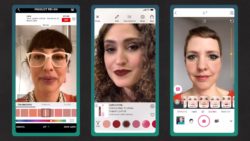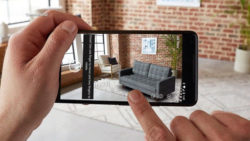Augmented Reality & the Shopping Experience


What is Augmented Reality?
Augmented reality, which is different from virtual reality, uses technology to enhance or manipulate a real-world environment and integrate the physical and virtual worlds. Less flashy than virtual reality, it’s actually used more in the day-to-day of most people, especially those with smartphones. Ever used Amazon’s “show it in my room” feature to decide whether or not a potential purchase would work in your home? That’s augmented reality, and it’s a feature that a lot of brands have adopted in the past few years.
Augmented reality has technically been around since the late 60’s and was used by researchers and government entities for a few decades, but consumer use of the technology blew up in the summer of 2016 with the release of Pokemon Go, a smartphone app that allowed users to hunt for Pokemon characters in the “real world.” Smartphone app Snapchat also made AR widely available when it introduced the feature to its users in the form of camera filters, most of which manipulated a person’s actual image to warp head shape, add ears or a tongue, or put heavy makeup on their face.
AR & Shopping
It was around this time that brands began to use AR for an enhanced shopping experience. Ikea was one of the first to try out the “show it in my room feature” and Topology Eyewear is just one of many eyewear brands that allowed customers to virtually try on glasses before purchasing them.
Now, a large number of brands with a shopping app have some sort of AR shopping feature. Besides Ikea, other brands who have followed suit include Home Depot, Wayfair, Target, Sephora, Amazon, Nike, Warby Parker, and Anthropologie. These brands allow users to test out how a product would look before making a purchase, which increases buyer confidence and makes the purchasing process easier.
The Perfect AR Opportunity
This feature was something that was nice to have, but not necessarily needed for shoppers. It was helpful for those who didn’t want to leave their home to see a product in person, measure it, or potentially have to return it after seeing it in their space. However, it became exponentially more helpful once people lost the choice to go see a product in-person, back in, say… March 2020? The pandemic not only increased use of AR in shopping, but created more opportunities for people to see how beneficial it could be. If brands didn’t already have an AR feature, they jumped on the bandwagon once their customers could no longer shop in-store. Kendra Scott was one of these brands, and they introduced an AR feature that allows customers to try on jewelry before purchasing.
Will AR shopping eventually make in-person shopping a thing of the past? It’s hard to say, but it’s certainly not going anywhere anytime soon. Are you looking to uplevel your brand’s marketing strategy? At PushCrankPress we are always wrangling up Brand New Ideas to keep your business one step ahead. Call us at 334.446.6149 to learn more.
Posted: Jul 20, 2021
